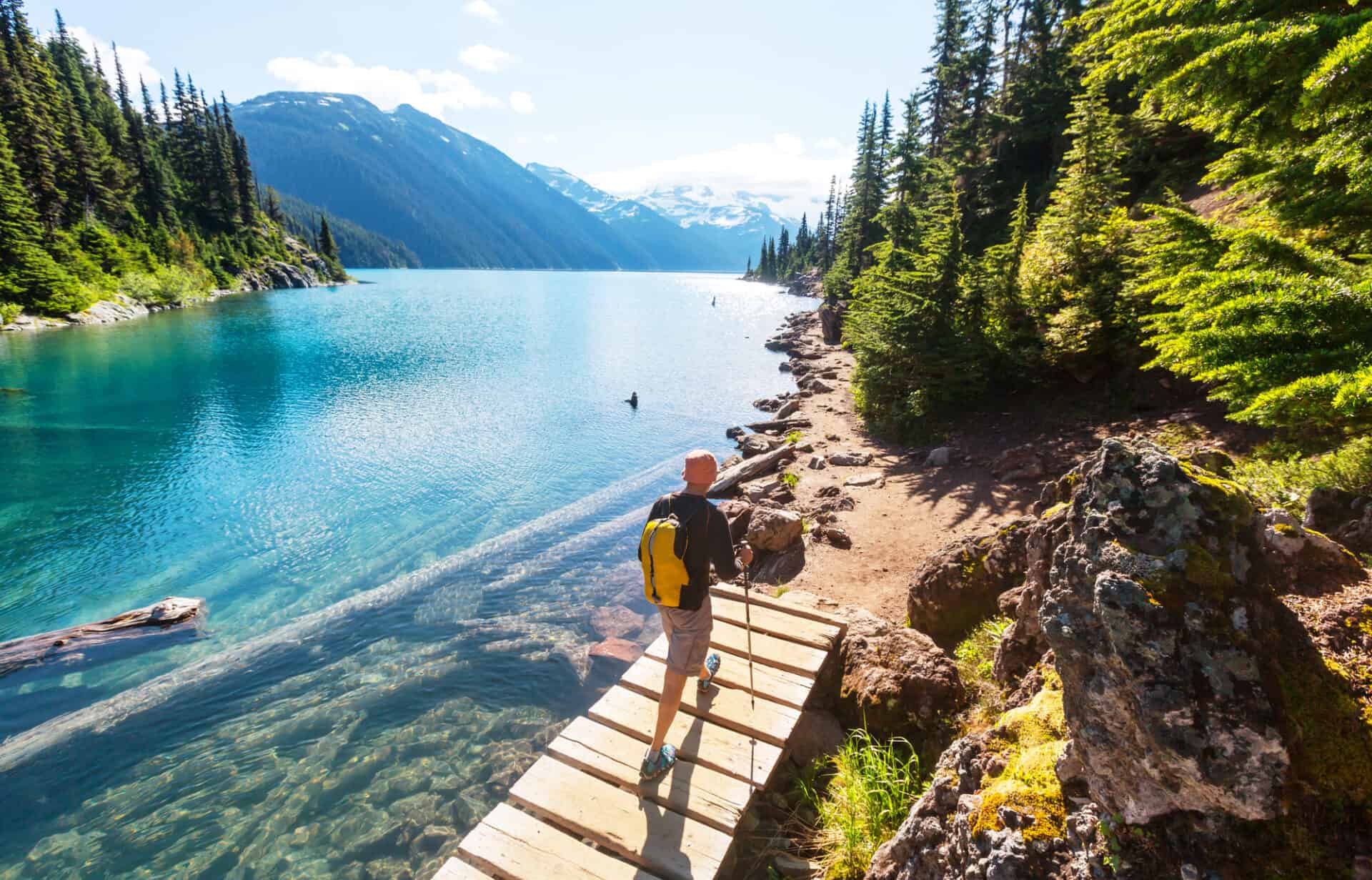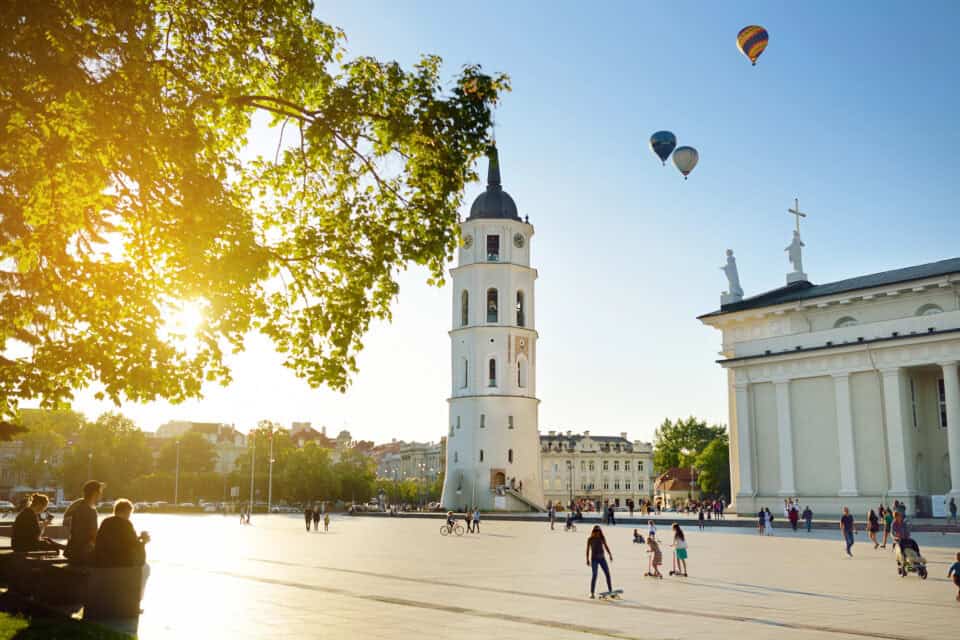Canada offers a vast and diverse range of walks and hiking tours, showcasing some of the most breathtaking natural landscapes in the world. Here are some of the nicest walks and hiking tours in Canada:
1. West Coast Trail, British Columbia:
The West Coast Trail (WCT) is a world-renowned trekking route located along the southwestern coast of Vancouver Island, British Columbia, Canada. It offers a challenging and rewarding adventure through lush rainforests, panoramic views and breathtaking scenery at every turn. Highlights include walking alongside towering old-growth trees, exploring tidal pools teeming with marine life, witnessing sunsets over the Pacific Ocean, and visiting landmarks like the Pachena Lighthouse and Tsusiat Falls. The WCT stretches approximately 47 miles (75 kilometers) and is known for its rugged terrain, including ladders, cable cars, suspension bridges, and challenging sections of rocky beach. The West Coast Trail takes 5 to 7 days to complete, depending on your pace and the number of stops you make along the way. To hike the West Coast Trail, you need a Parks Canada wilderness camping permit. Permits are limited to a specific number of hikers each day, so it’s recommended to make reservations in advance. The West Coast Trail is home to various wildlife species, including black bears, cougars, wolves, and marine mammals such as sea lions and whales. Proper food storage is essential to minimize the risk of encounters with wildlife. Respect the animals’ space and adhere to Leave No Trace principles to protect the fragile ecosystem.
2. Rocky Mountains (Various Trails), Alberta and British Columbia:
The Canadian Rockies provide numerous options, including hikes around Banff National Park, Jasper National Park, Yoho National Park, Larch Valley, and Wilcox Pass. You will encounter majestic peaks, crystal-clear alpine lakes, lush meadows, and ancient glaciers. The Rocky Mountains offer some popular treks: the Berg Lake Trail in Mount Robson Provincial Park, the Skyline Trail in Jasper National Park, and the Plain of Six Glaciers Trail in Banff National Park. The Rocky Mountains are home to a variety of wildlife, including bears, elk, moose, and mountain goats. Familiarize yourself with wildlife safety guidelines, such as properly storing food to avoid attracting animals. Keep a safe distance and respect their natural habitat. As with any outdoor adventure, practice Leave No Trace principles to minimize your impact on the environment. Pack out all garbage, stick to designated trails, and respect the flora and fauna. Leave the natural beauty of the Rocky Mountains as you found it for others to enjoy.
3. Cape Breton Highlands National Park, Nova Scotia:
Enjoy panoramic views of the Atlantic Ocean, explore dense forests filled with maple and birch trees, and discover hidden waterfalls. Keep an eye out for wildlife such as moose, foxes, and a variety of bird species. Cape Breton Highlands National Park, located in Nova Scotia, Canada, offers a picturesque trekking experience. The Skyline Trail, one of the most popular hikes, offers breathtaking views of the Gulf of St. Lawrence and Cape Breton Highlands. Other notable trails include the Franey Trail, Middle Head Trail, Acadian Trail, and the Coastal Trail along the rugged coastline. A permit is not required for day hiking but if you plan to camp overnight, you will need to obtain a backcountry camping permit. In addition to the natural beauty, Cape Breton Highlands National Park is rich in cultural and historical sites. Visit the Acadian fishing village of Chéticamp, explore the Gaelic-inspired heritage in communities like Ingonish, and learn about the Mi’kmaq First Nations’ connection to the land.
4. Gros Morne National Park, Newfoundland and Labrador:
Each trail offers its own unique features, such as coastal views, dense forests, waterfalls, and geological wonders. Some popular treks include the Gros Morne Mountain Trail, Green Gardens Trail, Western Brook Pond Trail, and the Tablelands Trail. What sets Gros Morne National Park apart is its geological significance. The park is a designated UNESCO World Heritage Site due to its exceptional examples of plate tectonics and ancient mountain formation. The Tablelands, a unique barren landscape with exposed Earth’s mantle, is a must-see highlight. Gros Morne National Park is home to a diverse array of wildlife and ecosystems. Keep an eye out for moose, black bears, foxes, and an abundance of bird species. Day hiking in Gros Morne National Park does not require a permit. However, if you plan to camp overnight, you will need to obtain a backcountry camping permit. In addition to its natural wonders, Gros Morne National Park is rich in cultural and historical significance. Explore the coastal communities nearby, such as Woody Point and Norris Point, where you can experience local culture.
5. Fundy Footpath, New Brunswick:
This challenging coastal hike takes you through Fundy National Park and offers views of the Bay of Fundy’s dramatic tides and rugged shoreline. It covers approximately 41 kilometers (25 miles) and typically takes 3 to 5 days to complete, depending on your pace and the number of stops you make along the way. The Fundy Footpath is known for its rugged and technical terrain, with steep ascents and descents, rocky beaches, and dense forests. The trail winds along the Bay of Fundy, showcasing dramatic cliffs, pristine beaches, waterfalls, and tidal rivers. It offers a remote and challenging wilderness experience. Highlights include crossing suspension bridges and exploring waterfalls such as Third Vault Falls. Hiking the Fundy Footpath requires a permit, which can be obtained through the Fundy Trail Parkway website. Permits are limited to preserve the wilderness experience, so it’s important to make reservations in advance. The Fundy Footpath is influenced by the extreme tides of the Bay of Fundy, which are among the highest in the world. It’s important to plan your treks around the tides, as some sections of the trail, such as Walton Glen Gorge and Big Salmon River, can only be crossed during low tide. As with any wilderness trek, it’s crucial to follow Leave No Trace principles. Pack out all garbage, minimize your impact on the environment, and respect the flora, fauna, and natural surroundings. Preserve the pristine beauty of the Fundy Footpath for future hikers to enjoy.
6. La Mauricie National Park, Quebec:
The Wapizagonke Lake Trail, the Waber Falls Trail, the Les Pins Trail and the Le Passage Lookout Trail showcase Quebec’s beautiful forests, lakes, and viewpoints. La Mauricie National Park, located in Quebec, Canada, offers a range of beautiful landscapes and trekking opportunities. Enjoy picturesque lakes such as Lake Wapizagonke and Lake Gabet, hike through dense forests of maple and birch trees, and bask in the tranquility of the park’s natural surroundings. Look out for wildlife such as beavers, moose, and various bird species. Familiarize yourself with park regulations, including guidelines for camping, campfire regulations, and waste disposal. Some trails may require a permit for hiking or backpacking, so be sure to check if any specific permits or fees are required for the trails you plan to explore. La Mauricie National Park provides excellent opportunities for photography and wildlife viewing. Capture the beauty of the landscape, photograph wildlife from a safe distance, and respect the animals’ natural behavior and habitat. Remember to keep a respectful distance and never feed or approach wild animals. Trekking in La Mauricie National Park offers a chance to immerse yourself in the natural beauty of Quebec’s wilderness.
7. Waterton Lakes National Park, Alberta:
Hikes like the Akamina Ridge Trail, the Carthew-Alderson Trail and the Crypt Lake Trail offer diverse terrain, including canyons and lake views. Waterton Lakes National Park, located in Alberta, Canada, allows you to experience the awe-inspiring beauty of the Canadian Rockies. The park encompasses towering mountains, turquoise lakes, cascading waterfalls, and diverse flora and fauna. Keep an eye out for wildlife such as bighorn sheep, mountain goats, and bears during your trek. Familiarize yourself with park regulations, including camping regulations, wildlife interaction guidelines, and waste management practices. Some trails may require permits, such as the Crypt Lake Trail, so be sure to check if any specific permits or fees are required for the trails you plan to hike. Waterton Lakes National Park provides excellent opportunities for photography and wildlife viewing. Capture the landscapes, the vibrant flora, and photograph wildlife from a safe distance. Remember to respect the wildlife’s natural behavior and never feed or approach wild animals. Trekking in Waterton Lakes National Park offers a chance to immerse yourself in the natural beauty of the Canadian Rockies.
8. Tonquin Valley, Alberta:
The Tonquin Valley, located in Alberta, Canada, offers a remote trekking experience in the heart of the Canadian Rockies. Accessible from Jasper National Park, this hike offers views of beautiful alpine lakes, glaciers, and towering peaks. The main trekking route is a loop that starts and ends at the Mount Edith Cavell trailhead. The trail spans approximately 44 kilometers (27 miles) and usually takes 3 to 4 days to complete. Highlights include the iconic Amethyst Lakes, peaks like Mount Edith Cavell and Mount Syme, and picturesque meadows filled with vibrant wildflowers. Keep an eye out for wildlife such as elk, mountain goats, and black bears. Familiarize yourself with proper wildlife encounter protocols and be respectful of their habitat. To hike and camp in the Tonquin Valley, you will need a national park pass, which can be purchased at the Jasper National Park gates or online. Camping is the primary accommodation option in the Tonquin Valley. Parks Canada operates backcountry campsites, such as Astoria, Portal Creek, and Surprise Point. Advanced reservations are required, and permits can be obtained through the Parks Canada website. Be respectful of the environment, ensuring minimal impact during your trekking experience.
9. Pacific Rim National Park Reserve, British Columbia:
Explore coastal rainforests and pristine beaches along the West Coast Trail or the shorter Nuu-chah-nulth Trail. Pacific Rim National Park Reserve, located on the west coast of Vancouver Island in British Columbia, Canada, offers a unique trekking experience and is known for its rugged coastline, ancient rainforests, and beautiful sandy beaches. The park offers a variety of trails, ranging from short walks to longer hikes. Some popular treks include the Wild Pacific Trail, the Rainforest Trail, and the West Coast Trail. Highlights include towering old-growth trees, ocean vistas, rocky headlands, hidden coves, and the opportunity to witness marine wildlife such as sea otters, whales, and seabirds. Pacific Rim National Park Reserve is renowned for its excellent surfing conditions, particularly at Long Beach. If you’re interested in water activities, you can try your hand at surfing, kayaking, or stand-up paddleboarding.
10. Bruce Peninsula National Park, Ontario:
Trekking in Bruce Peninsula National Park allows you to experience the unique beauty of the Niagara Escarpment and the surrounding ecosystem. Highlights include stunning views of Georgian Bay, ancient forests, wildflower meadows, limestone caves, and the famous Grotto, a scenic cave with a natural pool of azure water, and a popular spot for swimming, snorkeling, and diving. Bruce Peninsula National Park, located in Ontario, Canada, offers natural beauty and diverse trekking opportunities, a variety of trails, ranging from easy strolls to more challenging hikes. Some popular treks include the Cyprus Lake Grotto Trail, the Bruce Trail, and the Georgian Bay Coastal Trail. Stay on designated trails, as venturing off-trail can damage sensitive ecosystems. Bruce Peninsula National Park offers camping options for those interested in overnight stays. The park has several campgrounds equipped with basic amenities and facilities. Reservations are recommended, especially during the peak summer season.
Remember that hiking conditions in Canada can vary greatly depending on the region and time of year. It’s crucial to be prepared for changing weather, carry proper gear, and follow safety guidelines. Additionally, many of these hikes require advance planning, permits, and reservations, so make sure to research and plan accordingly. For more information and trail conditions visit the site of Parks Canada.

Preserving Natural Beauty: Conscious travelers appreciate the natural beauty of the destinations they visit and take steps to preserve it. They follow designated trails, avoid littering, and respect wildlife and natural habitats. By taking responsible actions, they contribute to the long-term preservation of these natural wonders.
Sustainable Impact: Conscious travelers prioritize sustainable practices that minimize their negative impact on the environment. They seek out eco-friendly accommodations, reduce waste, and support local businesses that promote sustainable practices, such as using renewable energy or incorporating recycling initiatives.
Leave No Trace principles: As with any outdoor adventure, it’s crucial to practice Leave No Trace principles. Pack out all garbage, dispose of waste properly, and respect the natural environment. Minimize your impact on the trail and leave it as pristine as you found it for future hikers to enjoy.
This article is part of the series by Conscious Travel Guide, your resource for mindful globetrotting.


